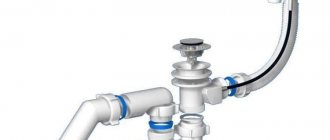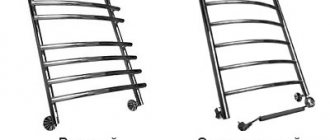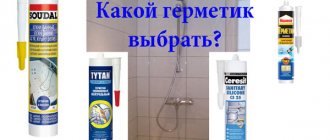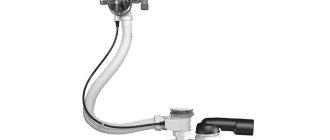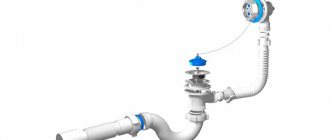Technical features of the system
Bathroom waste and overflow
The design of the drain and overflow consists of pipes tightly connected to each other and ensuring the necessary tightness. When water reaches the corresponding opening in an uncontrolled flow, the excess flows into plastic or flexible hoses and goes through the sewer pipe. A corrugated tube is a practical option, since in a small room area it bends and extends in any direction. The device is equipped with a siphon to protect the bathroom from unpleasant odors emanating from drainpipes.
External parts of the system are made of stainless or galvanized steel, which corresponds to its high quality and durability.
When purchasing a system, you should pay attention to the high-quality execution of all elements and mechanisms, as well as the presence of special seals and cuffs. If they are absent during operation, serious leaks often occur due to insufficient tightness of pipe connections. They can be purchased separately according to the diameter of the coupling or pipe.
Today there is a wide range of bath drains, the prices of which depend on the technical features, material and configuration. Manufacturers produce standard plastic versions, as well as models made of expensive metals with applied ornaments or engravings. There are the following types of drain-overflow systems:
- regular siphon with plug;
- semi-automatic system;
- automatic drain mechanism.
A certain type has advantages and disadvantages, but their use depends on the design features and individual needs.
Care Tips
There are no strict rules for operating the drain and overflow. Let's look at some tips for caring for this system:
- For automatic and semi-automatic devices, it is necessary to periodically process the parts to maintain the shine of the metal. Such care is carried out using glass cleaners or special products;
- Carry out regular inspections to identify possible leaks;
- If the seal is broken, you can replace the sealing material, or tighten the junction of the elements additionally;
- Siphon clogging is considered one of the most common problems in the operation of this system. Cleaning is carried out with a small brush attached to a wire or using a plunger;
- An alternative to mechanical cleaning is chemical treatment using special means. The alkali in such products helps neutralize the blockage due to its splitting effect;
- These measures can be applied not only to the problem of blockage. The best way to prevent such a problem is periodic maintenance of the system.
Automatic system: pros and cons
A characteristic feature of an automatic flush is a complex device with a “click-clack” valve button equipped with a latch and a spring. These keys come in a variety of designs and styles. The material used is copper or brass, coated with nickel or chromium. Among the advantages of the system are:
- convenience of draining water;
- compact design;
- practicality and effectiveness in various cases;
- presentable appearance.
Automatic drain-overflow also has disadvantages, such as: difficulties in repairing the button, installation complexity with the need to involve a specialist, low service life of the spring to hold the valve, high cost.
This system is often equipped with an additional function for filling the bowl with water. It is suitable when it is not possible to install a mixer. The diagram of such a drain in the bathroom consists of a pipe line connected to an overflow hole and a drain. When turned on, water is supplied to the bowl through a connector on the wall, and automatically stops when there is an excess of it.
Features of a semi-automatic siphon
Semi-automatic design
The most practical systems are considered to be semi-automatic. Their design is distinguished by the presence of a control unit on the outside of the overflow grille. The device is designed to adjust the tension of a special cable. One edge is connected to the block, and the other to the drain plug using a rod on the collar, while the plug is firmly connected to the system as a single mechanism.
The control unit is always located on the back side of the hole and is presented in different design forms:
- handle with pad;
- button;
- swivel ring.
To open the drain at the bottom of the bowl, you do not need to immerse your hand in the water; you just need to turn the ring or handle on the end side of the bathtub. She will tighten (to close the drain) or loosen (to drain water) the corresponding cable, lifting the plug.
The disadvantage of a semi-automatic system is the likelihood of the cable chafing and the bolt mechanism jamming, but this is directly related to the quality of the design. To protect yourself from such problems, it is recommended to choose equipment from trusted manufacturers that guarantee reliability and durability.
Build Quality Check
Installing an overflow drain is a fairly simple and quick process that requires some sequential steps. After direct installation, it is important to check the resulting structure to ensure its quality, as well as that no serious errors were made during the work process.
The bathtub is filled completely with water to check whether there will be any leaks at the connection point of the drain neck. The plug is removed, after which all other joints are checked for leaks.
If during the inspection process a leak is detected in any place, then the water is completely drained from the bath, after which the poor-quality connection is disassembled and reassembled further, and it is important to ensure that the nut and gasket are positioned correctly, since the main cause of the leak is a loose nut or a misalignment of the gasket.
Thus, a siphon is a must-have device for any bath. It is available in numerous types and models, and each type is installed using a special method.
If you plan to do the installation yourself, you should study all the features and nuances of this work so that in the end there are no leaks or other problems with the performance of the equipment. Due to the simplicity of the process, there are no difficulties in its implementation.
Standard drain system: simplicity and savings
The simplest drainage device in a bathroom is a system of pipes without mechanical or automatic levers or devices. A rubber or silicone plug is connected to the overflow grille on the wall of the bathtub via a metal chain and works by direct contact. The product range differs in the design of the pipe connection unit, the nature of the connection to the sewer pipe and the sealing of the joint areas. The system includes the following elements:
- A siphon is a removable zigzag pipe that is responsible for a water seal and preventing sewer odor from penetrating into the room. It is also a piping component for all pipes of the device. They vary in configuration, but the most common is the one with a deep shutter, where the amount of water held is more than 300 ml.
- Drain neck - connects to the hole located in the bottom of the bathroom. The design consists of an expanding tube with a built-in tightening nut and a chrome funnel that prevents debris from entering the siphon. The elements are connected using a reinforced stainless steel screw. The ring seal in the threaded part of the joint is made of high-quality rubber and is responsible for tightness.
- Overflow neck - installed on the wall of the bathroom and is structurally similar to the drain. However, the connection to the central network occurs exclusively through lateral drainage.
- Connecting tube - a soft corrugated tube connecting the siphon and the overflow hole, is necessary to drain excess water in the bowl. The connection to the elements is ensured by an overflow pipe.
- Auxiliary pipe – made in hard or soft design. Necessary for draining water from the siphon into the drain pipe.
The drain in the bathroom requires the presence of connecting devices to ensure the tightness of the joints. These include flat and cone-type gaskets complete with cap clamps. The latter is the most effective, as it provides reliable protection against leakage. The narrow part is inserted in the direction of flowing water into the opposite element and tightened with a nut.
Selected varieties
In addition to the design features of the structure, siphons differ in type and method of application:
- If there is no space under the sink for a conventional drainage device or it needs to be installed under the bathtub, then you can use a flat siphon. It is easy to install, takes up little space, holds odors perfectly, but it has one drawback: if it becomes clogged, you will have to disassemble the entire structure.
- Due to the increase in the number of household appliances, sink siphons with two or even three separate side fittings began to be produced. Thanks to them, you can connect a washing machine and a dishwasher to one drain at the same time.
- Complex devices are made for kitchen sinks that combine two or more pipes for connection to sinks with several sections.
USEFUL INFORMATION: Heated towel rails in the bathroom interior (photo)
Material selection criteria
Plastic product
When choosing which drain/overflow is best for your bathroom, you should pay attention to the material of manufacture. In Soviet times, drainage systems for plumbing equipment were made exclusively from ferrous metals, as they provided resistance to corrosion, hot water, acid and alkaline compounds. Despite the rapid loss of its presentable appearance, the material showed high resistance to changes in temperature and pressure.
Today, manufacturers prefer to use plastic and non-ferrous metals. The first ones are affordable and are used in bathrooms with installation. The elements are universal in size, so the structure can be mounted for different sewer outlets and installed in non-standard variations.
Metal systems are superior to plastic ones in durability and workmanship. Bronze, brass or copper appliances have an interesting design and construction. The gratings are painted with nickel or chrome plating using the galvanoplasty method. Such drains and overflows, subject to the rules of operation and periodic maintenance, guarantee a service life of more than 10 years.
You can determine what metal the system is made of yourself:
- bronze is a hard, dark brown metal composed of tin and copper;
- brass is a durable alloy of copper and yellow zinc;
- copper is moderately ductile and soft, with a reddish tint.
Installation of drain-overflow systems
Semi-automatic and automatic devices differ from conventional ones by the presence of special mechanisms that open and close the drain hole using a valve rather than a removable plug. When installing one or another system, the height of the bathroom drain is at least 15 cm. The semi-automatic device is equipped with a stylish control unit made of metal. When turned, the chrome ring tightly closes the drain using a closing element.
The automatic system features an improved mechanism consisting of a spring-loaded moving part and a button. The first element has the function of fixing in a closed or open state, thereby blocking the drain hole after pressing the button. The advantage of a semi-automatic device is that it opens the drain without having to put your hand in the water. The automatic device allows you to control the position of the valve not only with your hand, but also with your foot, which makes it practical to use.
First we choose the design of the siphon for the bathroom, and then the design
The familiar one is gradually disappearing from our homes, since modern devices allow us to open the water drain with one movement, rather than pulling out a rubber stopper by a chain. Especially when the bathtub is filled with hot water and the plug is firmly in place. Agree, this is very convenient. Therefore, we will not consider the familiar design of pulling out the cork. Let's focus on those that are the future. Of course, indicating the pros and cons of each device (after all, this is what the “Tips from an Experienced Plumber” blog is for). Today in plumbing stores

